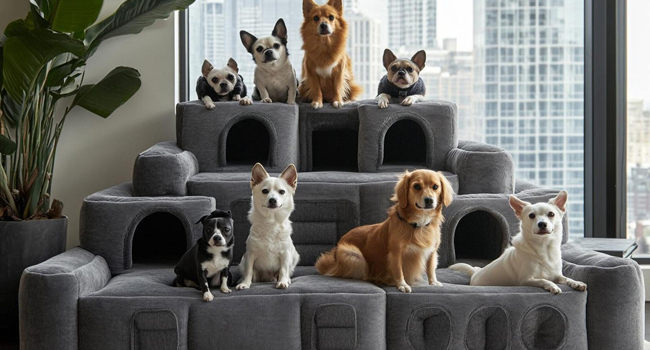

Sharing your life with multiple pets can be immensely rewarding, but it also requires thoughtful planning and careful management. Each animal has its own unique needs, temperament, and preferences, and introducing these differences into a shared living space can sometimes lead to conflict. When done right, however, a multi-pet household can offer a joyful and harmonious environment for both animals and humans alike. By understanding the dynamics between various pets and taking proactive steps, you can create a happy, cooperative home where each animal feels secure and valued.
Here's how to foster a harmonious multi-pet household, with practical tips for managing the unique dynamics that come with it.
The first few encounters between your pets are crucial. Animals are territorial by nature, and a sudden introduction can lead to stress or aggression. Start the introduction process slowly, especially if you're bringing in a new pet to a home where other animals are already settled.
Controlled Environment: Keep the new pet in a separate room initially, allowing the existing pets to sniff under the door. This helps them become familiar with the new scent without direct contact.
Supervised Meetings: Begin with short, supervised meetings in a neutral space where neither pet feels territorial. Keep the encounters brief and gradually increase the time they spend together as they become more comfortable.
Positive Reinforcement: Reward calm and positive behaviour with treats, toys, or verbal praise. If there are any signs of aggression, calmly separate the pets and try again later.
Patience and consistency are key here. Don't rush the process, as a gradual introduction allows for a stronger, long-term bond between the animals.
Each pet needs a personal space they can retreat to when they need a break. This is especially important in multi-pet households, as it helps each animal feel secure and reduces the likelihood of territorial disputes.
Dedicated Sleeping Areas: Provide individual beds or blankets in quiet spots where pets can relax undisturbed.
Separate Feeding Stations: Feeding time can quickly become a source of tension. Set up feeding stations in different areas to prevent any competition over food and ensure each pet eats without stress.
Litter and Toilet Zones: If you have multiple cats, ensure you have enough litter boxes - ideally one per cat, plus an additional one. For dogs, establish distinct toilet areas to avoid conflict over outdoor territory.
Respecting each pet's need for personal space goes a long way in maintaining peace and reducing stress.
Pets, like humans, find comfort in routine. Regular schedules for feeding, exercise, and playtime help each animal feel secure, especially in a shared home.
Scheduled Feeding Times: Feed your pets at the same time every day, and stick to this routine as closely as possible. This not only prevents food-related conflict but also reassures pets that their needs will consistently be met.
Designated Playtimes: Exercise and playtime are essential for both physical and mental health. Provide each pet with individual attention during play, especially if they have different energy levels or play styles.
Routine Vet Visits: Health issues can impact a pet's behaviour, so regular check-ups are essential. Early intervention can prevent potential health problems that might cause stress or discomfort for your pets.
A predictable environment minimises anxiety and encourages a peaceful household.
Encouraging positive, controlled interactions between your pets helps them develop a stronger bond. Gradually introduce shared activities that foster cooperation rather than competition.
Group Play: For dogs, engaging in group play with toys can help them bond through shared activities. Just ensure each dog has its own toy to avoid resource guarding.
Scent Sharing: Cats, in particular, communicate heavily through scent. Use scent-swapping techniques, like rubbing a cloth on one cat and then on the other, to introduce each animal's scent in a positive way.
Training Sessions: Joint training sessions can help both dogs and cats feel part of the family unit. Use commands to instil calm behaviour, rewarding each pet for good conduct during interactions.
Paying attention to each pet's body language can provide invaluable insight into how they're feeling. Signs of stress, fear, or aggression should be taken seriously to prevent any escalations.
Watch for Tension: Raised fur, growling, or hissing in cats, or stiff postures in dogs, indicate that an animal may be feeling threatened. Separate the pets if these behaviours arise and try reintroducing them slowly.
Look for Comfort Signals: Relaxed tails, gentle eye contact, and purring in cats or tail wagging in dogs often signal comfort and friendliness. Encouraging these interactions with treats or gentle praise reinforces positive associations.
Assess Emotional Needs: Every animal has unique emotional needs. For example, high-energy dogs might require more exercise, while cats may benefit from mental stimulation. Understanding these needs helps prevent frustration that could otherwise lead to negative behaviour.
Pets in multi-pet households can feel restless if they lack sufficient mental and physical outlets. This is particularly true for high-energy breeds or young animals who require more stimulation.
Interactive Toys: Puzzle feeders, treat-dispensing toys, and scratching posts offer excellent enrichment opportunities, especially for cats. These tools help prevent boredom and give each pet something to focus on independently.
Daily Exercise: Regular exercise, tailored to each pet's needs, keeps them physically fit and mentally balanced. For dogs, this could mean daily walks or play sessions; for cats, interactive toys or climbing structures can satisfy their instincts.
Social Enrichment: Playdates with other pets (where possible) or simply time spent engaging with humans provides essential social enrichment, building stronger bonds and minimising pent-up energy.
Sometimes, achieving harmony requires some fine-tuning. If conflicts persist, experiment with small adjustments, like rearranging spaces or introducing new activities that encourage teamwork rather than competition.
Reassess Interactions: Observe how pets interact over time, and be willing to modify your approach based on their behaviour. Some pets may need more individual time, while others might benefit from increased group activities.
Seek Professional Help if Needed: In some cases, conflicts persist despite best efforts. Professional trainers or animal behaviourists can offer tailored guidance to help address specific issues within your multi-pet household.
Handling a multi-pet household involves patience, planning, and ongoing adjustment. By focusing on proper introductions, respecting each pet's individual needs, and encouraging positive interactions, you can create a balanced and harmonious home environment. Remember, each pet has unique requirements and preferences, and finding the right approach may take time.
For pet owners looking to make their home even more comfortable for their furry companions, Eden Pet Care offers a variety of services tailored to support multi-pet households. Whether you're in need of grooming, boarding, or health check-ups, our team at Eden Pet Care is here to help you create the best possible environment for your beloved pets. Contact us today to learn more about our offerings and how we can support your journey to a harmonious multi-pet home!